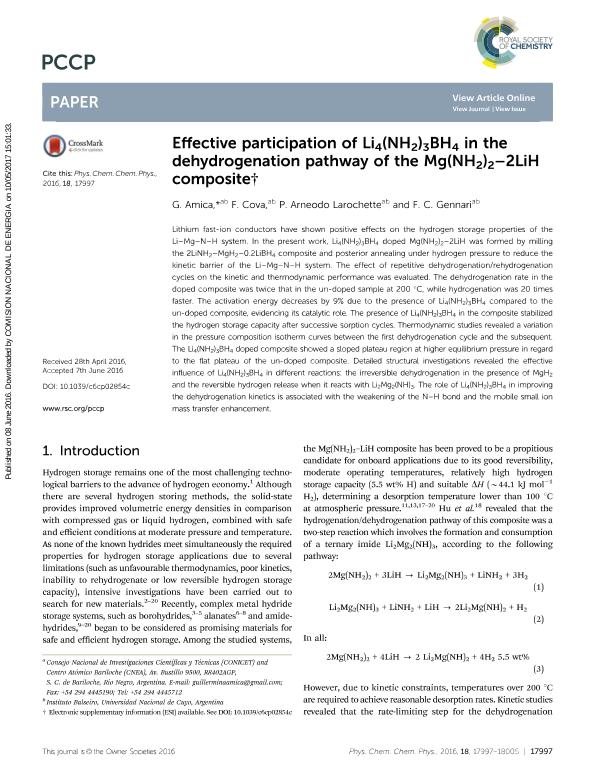Mostrar el registro sencillo del ítem
dc.contributor.author
Amica, Guillermina

dc.contributor.author
Cova, Federico Hector

dc.contributor.author
Arneodo Larochette, Pierre Paul

dc.contributor.author
Gennari, Fabiana Cristina

dc.date.available
2018-06-26T17:07:19Z
dc.date.issued
2016-06
dc.identifier.citation
Amica, Guillermina; Cova, Federico Hector; Arneodo Larochette, Pierre Paul; Gennari, Fabiana Cristina; Effective participation of Li4(NH2)3BH4 in the dehydrogenation pathway of the Mg(NH2)2-2LiH composite; Royal Society of Chemistry; Physical Chemistry Chemical Physics; 18; 27; 6-2016; 17997-18005
dc.identifier.issn
1463-9076
dc.identifier.uri
http://hdl.handle.net/11336/50090
dc.description.abstract
Lithium fast-ion conductors have shown positive effects on the hydrogen storage properties of the Li-Mg-N-H system. In the present work, Li4(NH2)3BH4 doped Mg(NH2)2-2LiH was formed by milling the 2LiNH2-MgH2-0.2LiBH4 composite and posterior annealing under hydrogen pressure to reduce the kinetic barrier of the Li-Mg-N-H system. The effect of repetitive dehydrogenation/rehydrogenation cycles on the kinetic and thermodynamic performance was evaluated. The dehydrogenation rate in the doped composite was twice that in the un-doped sample at 200 °C, while hydrogenation was 20 times faster. The activation energy decreases by 9% due to the presence of Li4(NH2)3BH4 compared to the un-doped composite, evidencing its catalytic role. The presence of Li4(NH2)3BH4 in the composite stabilized the hydrogen storage capacity after successive sorption cycles. Thermodynamic studies revealed a variation in the pressure composition isotherm curves between the first dehydrogenation cycle and the subsequent. The Li4(NH2)3BH4 doped composite showed a sloped plateau region at higher equilibrium pressure in regard to the flat plateau of the un-doped composite. Detailed structural investigations revealed the effective influence of Li4(NH2)3BH4 in different reactions: the irreversible dehydrogenation in the presence of MgH2 and the reversible hydrogen release when it reacts with Li2Mg2(NH)3. The role of Li4(NH2)3BH4 in improving the dehydrogenation kinetics is associated with the weakening of the N-H bond and the mobile small ion mass transfer enhancement.
dc.format
application/pdf
dc.language.iso
eng
dc.publisher
Royal Society of Chemistry

dc.rights
info:eu-repo/semantics/openAccess
dc.rights.uri
https://creativecommons.org/licenses/by-nc-sa/2.5/ar/
dc.subject
Amides
dc.subject
Hydrogen
dc.subject.classification
Otras Ciencias Físicas

dc.subject.classification
Ciencias Físicas

dc.subject.classification
CIENCIAS NATURALES Y EXACTAS

dc.title
Effective participation of Li4(NH2)3BH4 in the dehydrogenation pathway of the Mg(NH2)2-2LiH composite
dc.type
info:eu-repo/semantics/article
dc.type
info:ar-repo/semantics/artículo
dc.type
info:eu-repo/semantics/publishedVersion
dc.date.updated
2018-06-06T21:05:04Z
dc.journal.volume
18
dc.journal.number
27
dc.journal.pagination
17997-18005
dc.journal.pais
Reino Unido

dc.journal.ciudad
Cambridge
dc.description.fil
Fil: Amica, Guillermina. Consejo Nacional de Investigaciones Científicas y Técnicas; Argentina. Comisión Nacional de Energía Atómica; Argentina
dc.description.fil
Fil: Cova, Federico Hector. Consejo Nacional de Investigaciones Científicas y Técnicas; Argentina. Comisión Nacional de Energía Atómica; Argentina
dc.description.fil
Fil: Arneodo Larochette, Pierre Paul. Consejo Nacional de Investigaciones Científicas y Técnicas; Argentina. Comisión Nacional de Energía Atómica; Argentina
dc.description.fil
Fil: Gennari, Fabiana Cristina. Comisión Nacional de Energía Atómica; Argentina. Consejo Nacional de Investigaciones Científicas y Técnicas; Argentina
dc.journal.title
Physical Chemistry Chemical Physics

dc.relation.alternativeid
info:eu-repo/semantics/altIdentifier/doi/http://dx.doi.org/10.1039/C6CP02854C
dc.relation.alternativeid
info:eu-repo/semantics/altIdentifier/url/http://pubs.rsc.org/en/Content/ArticleLanding/2016/CP/C6CP02854C
Archivos asociados
